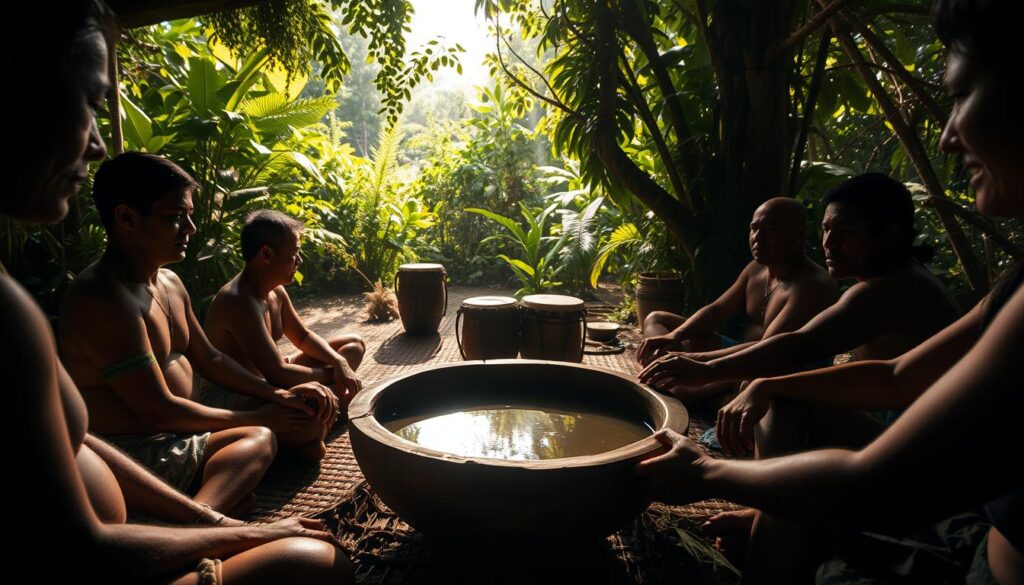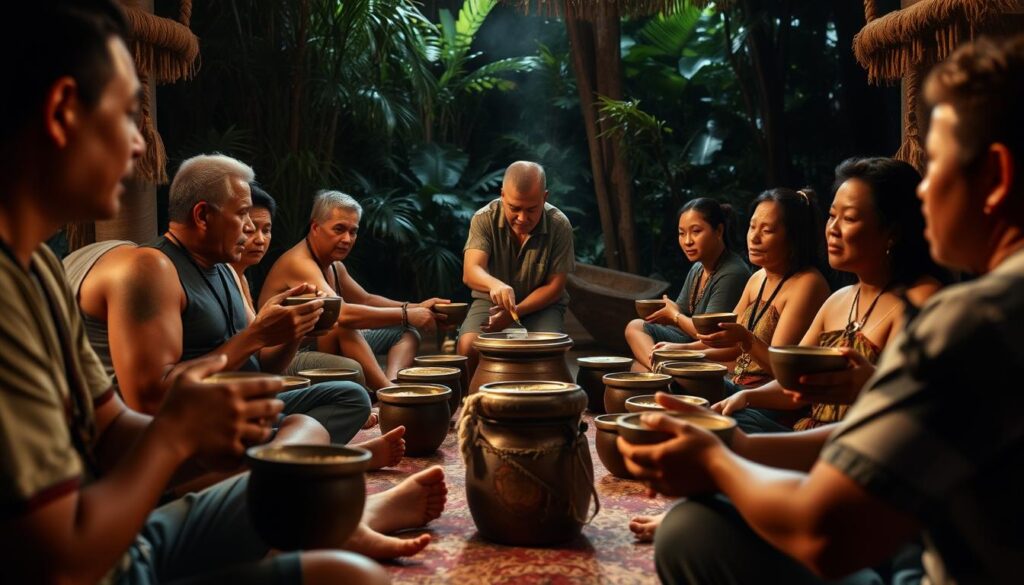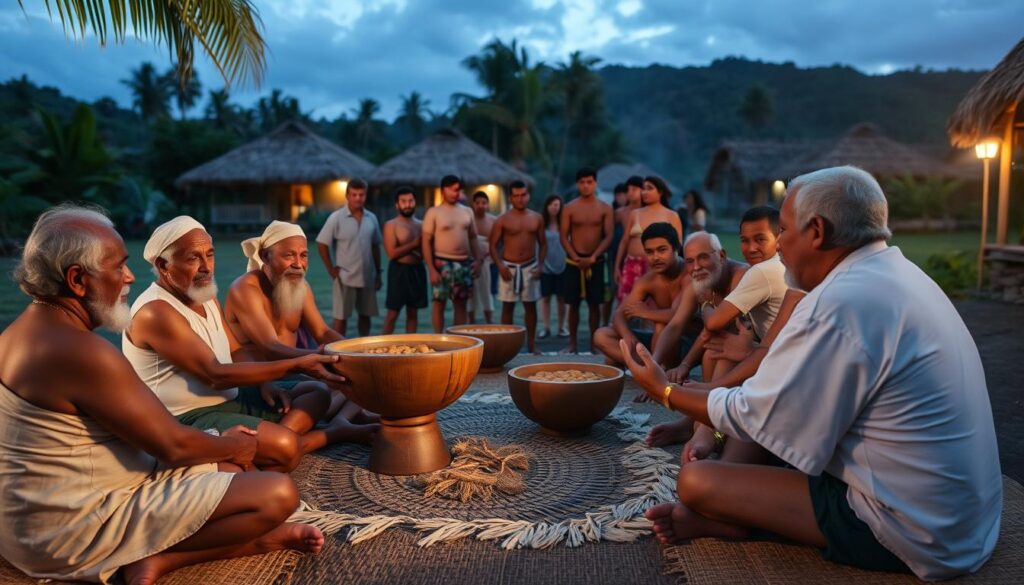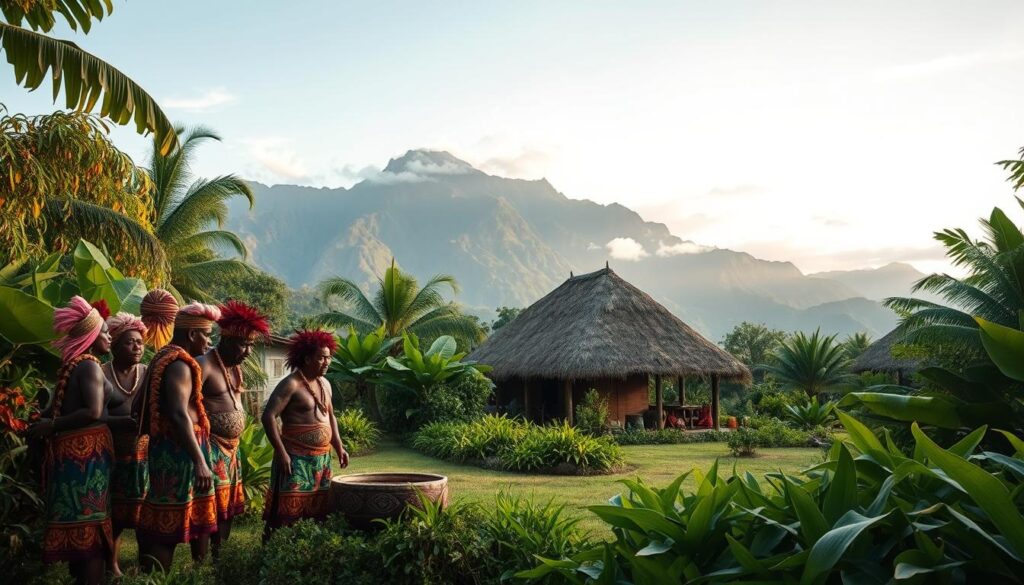Did you know that over 85% of Fijians regularly take part in kava ceremonies? This shows how important kava ceremonies are in Fijian culture. They offer a special way to connect with the local community.
When you join a traditional Fijian kava ceremony, you’ll feel a warm welcome. You’ll hear stories, laugh, and experience true hospitality.
Before diving into this authentic Fijian experience, knowing what to expect is key. This guide will help you understand the customs and rituals of these ceremonies. This way, you can fully enjoy and respect Fiji’s vibrant culture.
Key Takeaways
- Fijian kava ceremonies are central to community bonding.
- Participating in a kava ceremony offers a glimpse into local traditions.
- Understanding the customs enhances your overall experience.
- Warm hospitality is a hallmark of kava ceremonies.
- Respect and participation are key to the experience.
Understanding Kava: The Heart of the Ceremony
Kava is key in the kava ceremony culture fiji, more than just a drink. It’s called yaqona or grog, made from yaqona plant roots mixed with water. Making this drink is important for building community and improving social bonds.
When you try a kava drink experience, you learn about its effects. Kava acts as a *social lubricant*, enjoyed at big events like welcoming guests or solving problems. It helps people relax, making it easier to talk and share important moments.
Understanding the cultural value of fijian kava makes your ceremony experience richer. This drink connects people and communities, showing respect and hospitality.
| Kava Aspect | Description | Significance |
|---|---|---|
| Preparation | Crushed root mixed with water | Shows care and effort in welcoming guests |
| Cultural Role | Social interactions and community bonding | Promotes harmony and relationships among participants |
| Occasions | Celebrations, disputes, and greetings | Actively involved in significant life events |
What is a Fijian Kava Ceremony?
A traditional Fijian kava ceremony is a lively event where people gather to share kava from a big bowl, called the tanoa. It shows the importance of respect, hospitality, and community in Fijian culture. It’s a time when locals and visitors come together, strengthening their bonds.
In these ceremonies, everyone works together to make and drink kava. This creates a sense of unity and togetherness. You’ll see rituals like welcoming speeches and the serving of kava, all filled with tradition and meaning. It’s not just about drinking kava; it’s about connecting with the culture and the people.
This ceremony is key in Fijian life, linking the past to the present. It’s a place for stories and sharing experiences. It helps keep Fijian heritage alive for the next generations.

The Cultural Significance of Kava in Fijian Society
Kava is a big part of Fijian life, more than just a drink. It shows respect and brings people together, showing the heart of Fijian culture. The kava ceremony tradition is key at big events like births, weddings, and community meetings.
Being part of a kava ceremony is a special fijian cultural experience. It builds a sense of community and connection to the past and present. You’ll hear stories, laugh, and share deep talks, showing how kava strengthens bonds.
Learning about kava’s cultural importance is key for those interested in Fijian heritage. It’s not just about drinking it; it shows the Fijian values of unity, welcome, and strong relationships.
Experience a Traditional Fijian Kava Ceremony: What to Expect
Joining a traditional Fijian kava ceremony lets you see local culture up close. You’ll feel the warmth of your hosts as they welcome you into a circle of friends. The vibe is chill, perfect for swapping stories and enjoying laughs.
This experience shows how important connection is in Fijian culture. It’s all about coming together and feeling like you belong.
At this authentic Fijian kava event, you’ll see how kava is prepared and served. Each sip brings everyone closer together. You might find yourself bonding with others as you share this special moment.
The calm setting and kava’s gentle effects make it even more enjoyable. It’s a chance to connect deeply with those around you.

Preparing for a Traditional Fijian Ceremony
Attending a kava ceremony in Fiji can be a unique experience. Knowing the right steps to prepare can make it even more special. It’s important to respect local customs, like the dress code and bringing a gift.
Dress Code for Kava Ceremonies
It’s key to follow the dress code to show respect for Fijian culture. Women should wear skirts or dresses that cover their shoulders. This shows modesty and respect. Men should wear long pants or sarongs to be properly dressed.
Bringing a Gift: Traditional Kava Root
Bringing a gift, like traditional kava root, is a big part of the ceremony. It shows respect for Fijian customs and the cultural importance of kava. Giving kava makes the experience richer and connects you to the event’s significance.
Kava Ceremony Etiquette: How to Behave
Being part of a fijian culture experience in a kava ceremony is more than just drinking the kava. It’s about following the kava drinking etiquette. This ensures the ceremony goes well and is respectful. Knowing how to behave shows respect for the local culture and its people.
Physical Manners During the Ceremony
When you’re in a fijian kava ceremony, pay attention to your body language. Sit cross-legged around the tanoa, a traditional bowl for kava. Don’t point your feet at others, as it’s seen as rude.
When you get your kava in a coconut shell, clap once and say “Bula” to your host. This shows thanks and builds community during the ceremony.

The Kava Preparation Process
Preparing kava is key to the kava ceremony. It involves grinding the yaqona root carefully. This step is vital for the right taste and texture. It shows the deep respect for traditional kava ceremonies and Fijian traditions.
Grinding and Straining the Kava
The first step is grinding the kava root into a fine powder. This is often done by skilled clan members. They mix the powder with water in a big bowl.
Then, they strain the mixture. This leaves only the liquid, called “kava gold.” It’s a drink that brings people together.
Preparing kava is more than cooking. It’s about unity, respect, and sharing traditions. Watching this part of the ceremony gives insight into Fijian values and customs.
| Step | Description |
|---|---|
| Grinding | Yaqona root is ground into a coarse powder using traditional tools. |
| Mixing | The powder is combined with water in a bowl, creating a thick mixture. |
| Straining | The mixture is strained to yield a smooth, drinkable liquid. |
| Serving | The final kava is served in ceremonial cups for participants to enjoy. |
What Happens During the Kava Ceremony?
A kava ceremony is a mix of tradition and respect, showing the heart of Fijian culture. It starts with a welcome from the chief, setting the stage for a gathering focused on social bonds and shared history. The kava service shows the importance of rank, meeting fijian kava ceremony expectations.
The Order of Serving Kava
Kava is given out in a special order, showing respect for the group’s hierarchy. The chief gets it first, showing respect and authority. Then, other important people get it, following kava drinking customs fiji. This way, everyone feels included and connected through the ceremony.
Common Practices and Rituals
During the ceremony, there’s clapping, singing, and storytelling, adding to the fun. These activities blend with kava drinking, making the experience rich. People laugh and share stories, strengthening their bonds and celebrating their culture. The rituals help honor kava and build a sense of community among all.

The Taste and Effects of Kava
Kava offers a unique journey for those who try it. It’s important to understand its flavor and the feelings it brings.
Flavor Profile of Kava
Kava tastes earthy and a bit bitter. It’s often compared to muddy water, which some find hard to like at first. But, as you get used to it, you start to enjoy its complex flavors.
This drink is a big part of Fiji’s kava ceremony culture. People learn to love its unique taste, connecting deeply with the culture.
Physical Sensations After Drinking Kava
After drinking, you might feel calm and relaxed. The drink can make your mouth feel a bit numb. As it takes effect, stress fades away, leaving you peaceful.
This mix of taste and feeling makes Fiji’s kava ceremonies special. It’s more than just a drink; it’s a shared experience.
| Aspect | Description |
|---|---|
| Taste | Earthy, similar to muddy water, bitter aftertaste |
| Initial Sensation | Mild numbness in the mouth |
| Effects | Calming, relaxing, stress relief |
| Cultural Significance | Integral to the kava ceremony culture Fiji |
Connect with Fijian Culture Through Kava Ceremony
Joining a kava ceremony is a special way to dive into Fiji’s culture. You connect with local traditions and share a drink that links you to the community’s history. This experience helps you make friends, as everyone plays a key role in the ceremony.
The ceremony’s vibe is friendly and full of laughter and stories. Sitting with the locals, you see the heart of Fijian culture. Every step, from making kava to drinking it, shows respect for community.

This journey lets you see the true spirit of Fijian life. Drinking kava with others helps you understand their beliefs and values. It makes your trip through Fiji’s beautiful landscapes even more meaningful.
Celebrations Following the Kava Ceremony
After the kava ceremony, the mood shifts to fun and calm. People start dancing and singing, filling the air with joy. These moments help everyone bond, which is key in Fijian culture.
These parties are not just for fun. They also help people get closer to each other. The laughter and togetherness show how kava brings people together. It’s a time to make memories and share experiences.
The mix of ritual and celebration makes the event special. It shows how important kava is in Fijian life. The fun doesn’t stop after the ceremony. It keeps going, creating moments of unity and happiness.
Conclusion
To truly experience a traditional Fijian kava ceremony is to gain insight into Fiji’s vibrant culture. Each gathering celebrates deep-rooted customs and bonds that unite the community. You’ll find that the fijian kava ceremony rituals are more than just drinking kava—it’s a chance to connect with locals and their traditions.
When you engage in this authentic fijian experience, be open-hearted and respectful. The connections you make during the ceremony will deepen your understanding of Fijian life. You’ll leave with cherished memories that will last long after your visit.
In summary, embracing the kava ceremony lets you enter a world where tradition and community blend. By diving into this unique cultural experience, you enjoy kava’s flavors and partake in Fiji’s enduring spirit.
